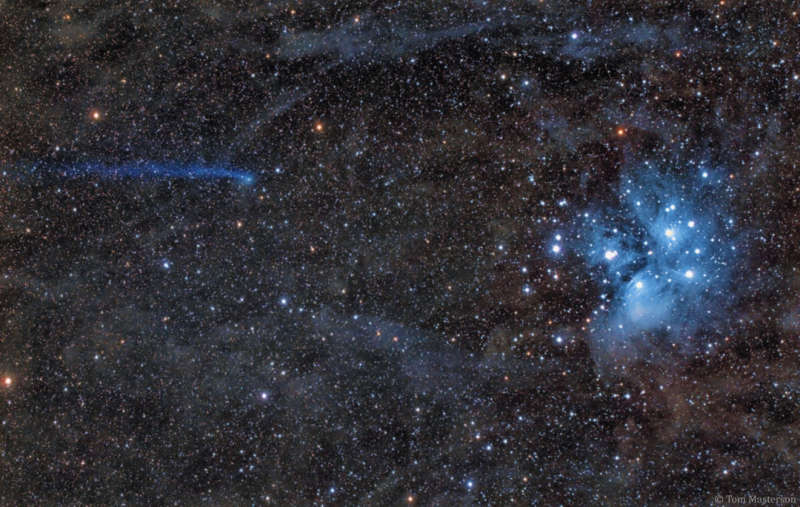
|
Credit & Copyright: Tom Masterson
(Transient Astronomer)
Explanation:
What's that heading for the Pleiades star cluster?
It appears to be
Comet C/2016 R2 (PanSTARRS), but
here, appearances are deceiving.
On the right and far in the
background, the famous
Pleiades star cluster
is dominated by blue light from massive young stars.
On the left and visiting the inner Solar System is
Comet PanSTARRS, a tumbling block of ice from the outer
Solar System that currently sports a long
ion tail dominated by
blue light from an unusually high abundance of ionized
carbon monoxide.
Comet PanSTARRS is actually
moving toward the top of the
image, and its ion tail points away from the
Sun but is affected by a complex
solar wind of particles streaming out from the Sun.
Visible through a small telescope, the comet is fading as it recedes from the
Earth, even though it reaches its closest point to the Sun in early May.
|
January February March April May June July August September October November December |
| ||||||||||||||||||||||||||||||||||||||||||||||||
NASA Web Site Statements, Warnings, and Disclaimers
NASA Official: Jay Norris. Specific rights apply.
A service of: LHEA at NASA / GSFC
& Michigan Tech. U.
Based on Astronomy Picture
Of the Day
Publications with keywords: comet - pleiades
Publications with words: comet - pleiades
See also:
- APOD: 2025 September 30 Á Comet Lemmon Brightens
- APOD: 2025 September 29 Á Two Camera Comets in One Sky
- APOD: 2025 September 26 Á A SWAN an ATLAS and Mars
- APOD: 2025 September 18 Á Comet C/2025 R2 SWAN
- APOD: 2025 September 16 Á New Comet SWAN25B over Mexico
- APOD: 2025 August 25 Á The Meteor and the Star Cluster
- APOD: 2025 July 8 Á The Pleiades in Red and Blue
